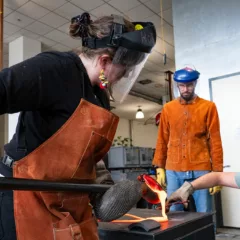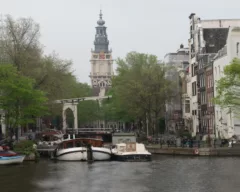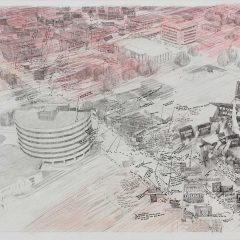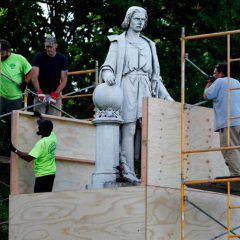Our plane from JFK touched down on Norwegian soil around 9:15 AM, Oslo time. My last aerial glances revealed Norwegian fields spread over long ripples of irregular landscape like crinkled foil, the plots creating a puzzle (not of squares like in America’s Midwest) but of triangles and polygons, which suggested people in a more relaxed oneness with the land.

Norway and the Arctic Circle
Norway is a country whose terrain is lush moss lands, down-soft evergreens, and a rugged mountain surface. Perfect for my travel companion, Dan, my regular camping partner, and I because we had camping on the mind. Immediately struck by the prohibitive prices of Oslo, we fled west for the mountains, but not before visiting the Viking Ship Museum—a temple/showroom for 900-year-old timber boats of exquisite craftsmanship.
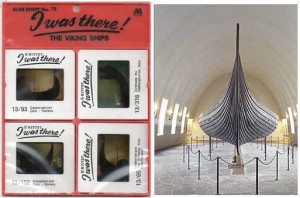
The first stop of my northern European tour which would also include Germany and Holland, Norway benefits from a rich economy and tremendous transportation infrastructure, so traveling without a car is easy and pleasant even in the smallest of villages. After some conversation with the agent at the bus counter who was disgruntled by our butchering the local pronunciation, we hopped on a half-full bus to Kongsberg, a wealthy city with a history of silver-mining, where we transferred to another less populated bus to Bolkesjø. The friendly, crew cutted driver dropped us on the side of a narrow road where the trail began. After a two-day hike to the tallest peak in Oslo’s vicinity (most of which was above the tree line and led us to ice clear glacial lakes and cranberry-colored moss), we knew we wanted to go north to the Arctic.
We boarded a train from Oslo toward Trondheim, an eight hour ride. Accidentally we rode first class. I sat at a real wooden table with hinged extension pieces that optionally folded out. Instead of the neon-patterned carpet that adorns most charter bus seats, ours were a tasteful mustard. Complimentary coffee and tea plus large-paned windows offering serene views of still blue water and occasionally snowy hillsides made for a delightful journey. I saw a reindeer through the window as we flashed by, its large back toward me, sand-colored head craned over its left shoulder.

In Trondheim, we had a quick transfer to another train for Bodø, the northern limit of the national rail line. I devote so much attention to these train rides because they were artistic experiences in and of themselves–we were spectators of a beautiful, silent film, unreeled mile afer mile.
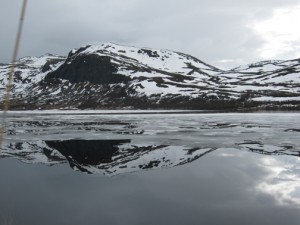
The train to Bodø was not the slick design from earlier; it was a relic from the past: a blue and red fantasy with large knobs on levers for seat adjustment and sturdy chrome luggage racks. This time, barely managing to get seats, we sat two facing two, our four legs interweaving with the strangers’ across from us. We boarded the train shortly before midnight. Everyone hunkered down for the ten hour ride with their provided blankets, eye masks, and inflatable pillows. The light faded, but never seemed to extinguish. Around 3AM, I awoke as we passed through Mo I Rana, meaning we had entered the Arctic Circle. Inside, passengers were asleep under red blankets and dark masks, but the Polar Express sped onward.
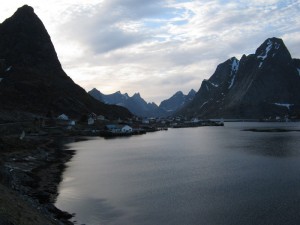
From Bodø, we took a northwesterly ferry to Lofoten, an archipelago. Indescribably picturesque, Lofoten has small, but craggy mountains that reach directly out of the sea. The bay water is Caribbean turquoise. The villages we visited are fishing communities; drying cod bodies hang by the thousands from wooden scaffolding, which give the air a pungent odor.
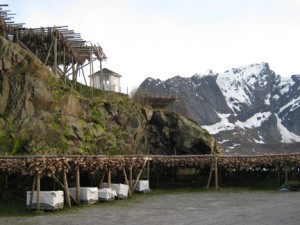
We took a smaller ferry to a village accessed by telephone lines, but no road. From there, we hiked over the valley to a beach we had all to ourselves with light-colored sand—a white isle of isolation. In the evening, the fog rolled in so heavy the beach was a sheet of pale grey with barely distinguishable darker silhouettes of the peaks in the near distance. We never saw the sun set while in Lofoten—summer is the season of the “Midnight Sun”—and we were frequently confused upon pulling out our cell phone to check the time at dinner.
Part of our initial inspiration to go to Norway was pictures of strange looking Medieval churches: massively tall wooden structures that date back to the Viking Age. We visited one near Bergen, the Borgund Stave Church, supposed to be the best preserved in its original form. This one was surrounded by scaffolding when we visited. The 6-tiered structure looks something between a tree house and an Asian temple. On one roof there is carved detailing, visible in profile, of patterns almost floral that dip into what appears to be runic script, and the wood left in tact from hundreds and hundreds of years ago is aged to a rich orange color or coated with a black, bubbly texture (likely ancient tar spread over the wood for preservation).
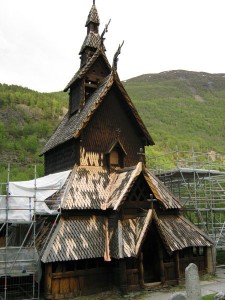
Berlin
Our two weeks in Norway finished and Dan had to return to work. I flew Ryanair to Berlin and spent five nights with no agenda except to explore. People around me were no longer speaking Norwegian, but a tongue slightly more gargly. The sun was bearing down on us, warming the air to the mid 80s. I basked in the ability to afford restaurant food; my first meal was a plate spilling over the sides with couscous and vegetables plus a cappuccino for 6€ (Seerose, Mehringdamm 47, Kreuzberg).
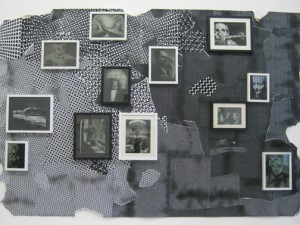
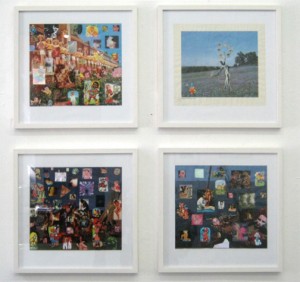
I spent two days looking at galleries to get an idea of the contemporary scene there, but after day one of walking along Auguststraße was sorely discouraged. In the end, I was impressed by two installations. The first was a group show at Kunststiftung Poll, tucked away in an airy courtyard. Jack Holden’s painting-collages and Fabian Seyd’s wall installation stood out. Helen Marten’s installation at Johann König, however, was the ultimate experience. Of particular inspiration to me was the “Rustic’s Ransom” series (a small part of a large installation): three “paintings” of Corian–an industrial material used for counter tops. Each had a grouping of clunky Nokia phones and a manicured chunk of hardwood with a hopeful, baby tree growing from it embedded partway in the matte, semi-translucent surface. They were strapped to the wall (as if held hostage) by powder-coated braces. I was attracted by their triple personalities: aligned ambiguously with commercial culture via the Nokia phones, they remained immersed in the art-object world by nature of their formal properties, while, thirdly, looked like they were ready to embark on a camping trip–a curious statement about the relationship of nature and commerce, which suggests the trees are ready for payback.

Bonn
From Berlin, I boarded a bullet-nosed train toward Bonn, where a friend is doing a fellowship. The train’s sterile, grey interior made me long for romantic journeys on Norwegian locomotives. In Bonn, the little brother to Cologne, I found an absolute gem of an art museum with a collection of dazzling Sigmar Polke paintings. I spent three days with my friend, sleeping in his salmon pink hotel room. On our final day together we journeyed an hour and a half to Duisburg to visit the Duisburg Nord Landschaftspark, what was once a steelyard. We climbed the blast furnace to take in immense views of the industrial landscape, still pumping smoke (and Ikea). Germany has a number of architecturally poignant green spaces that are reclaimed industrial sites turned parks. The dominant philosophy is to leave in tact as much as possible the original site while encouraging plant growth to intermingle naturally.
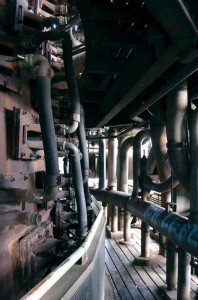
Amsterdam
Leaving Germany for Amsterdam, the last leg of my journey, I would be on a plane back to New York in four day’s time. I met up with my mother and succumbed to being a regular tourist. We did a boat tour through the canals, rented bicycles, made a picnic in Vondelpark, and visited the museums. On our final night, we took our bikes to the Museum Plein, a short distance from the hotel. The light at six o’clock gave no indication of waning any time soon. We sat on a manicured field facing the side of the Stedelijk museum, with a small TV crew behind us. John Baldessari, who was my mother’s mentor in art school and, thus, had special significance to us, was mounting an outdoor installation of scrolling LEDs in which participants could have their name displayed enormously for fifteen seconds of fame. Museum curators and their children exclaimed with excitement every few minutes as their names passed by in blinking color. The level of cheese connoted by the bright colors and flashing, rotating patterns of stars was appropriate.
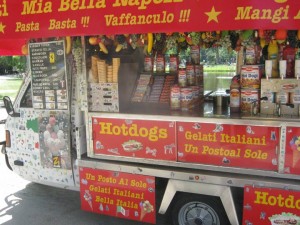
Back in our hotel room, my mother and I tried with to see if we were captured on film by the tv crew and were stars of the national news, but finally giving up, we clicked the TV off. I slept soundly that night, tucked into my crisp hotel sheets. Next morning, as I boarded the bus to Schiphol Airport, I wondered what the weather was like back in New York.


